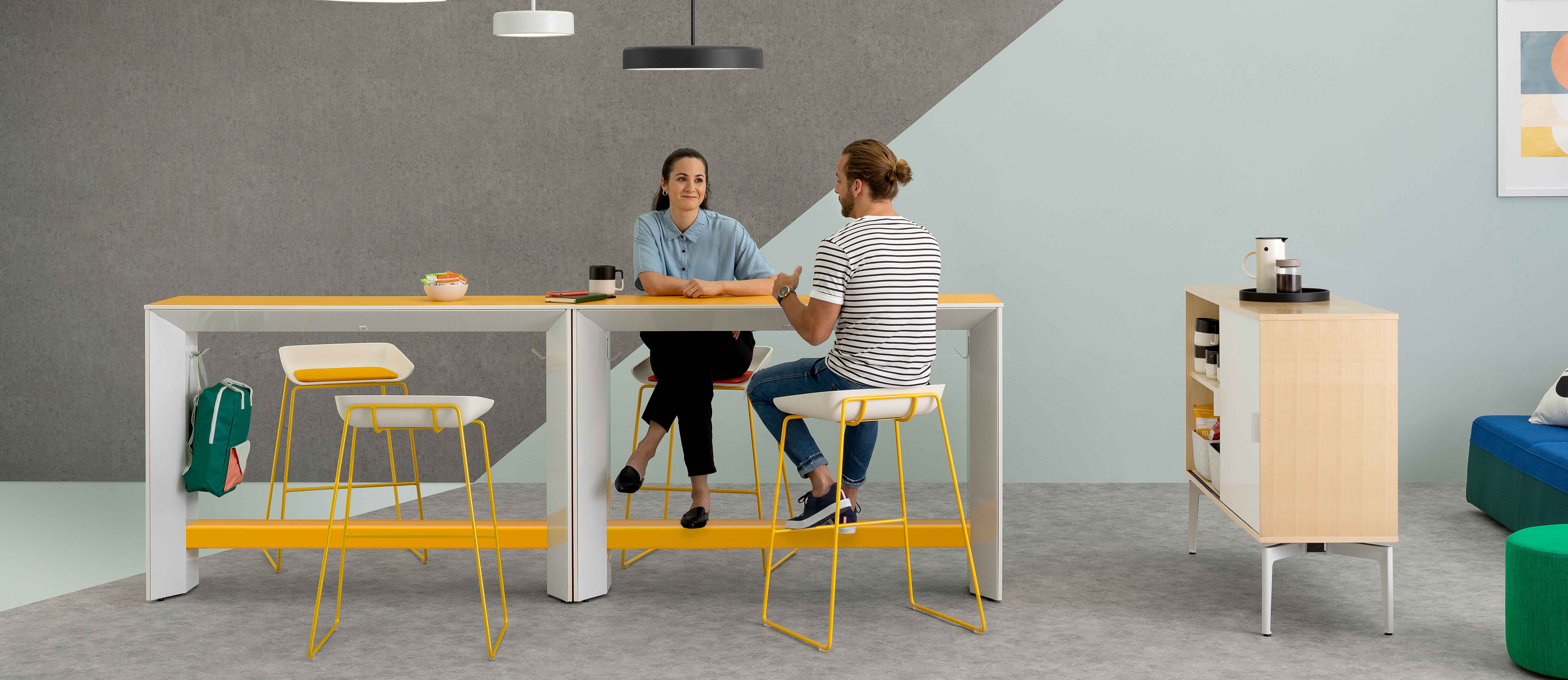The workplace is evolving, the generations in the workplace are changing. New demands are being created by emerging technologies, minimized real estate footprints, aging workforce and evolving expectations from millennial workers (1977+).
It’s never been more important to understand how the workplace can help. The places where we work have an impact on how people think and feel and how well they perform. We believe when you think about people, place and technology together as a holistic ecosystem, you can create a great employee experience where people thrive.
GSA Workplace 2020 Goals:
1. Improve Collaboration And Communication
In addition to bursts of solitary activity, a typical day for workers includes many brief stand-up conversations, opportunistic encounters, “on the fly” meetings, and planned meetings of various sizes. The importance of collaboration and knowledge sharing and the need to support mobile workers and teams mean that the workplace is increasingly “where people meet to interact” rather than a setting for individual, heads-down work. Both collaboration and individual work still occur, of course, but it is crucial to provide a range of settings to support informal and formal interaction. We need to balance all of this with the need to accommodate focused work, a growing issue as the workplace becomes denser and more open. Workplace features that support this goal include increased internal visibility, more space for interaction, and a greater variety of meeting rooms.
2. Improve Environmental Quality
Under the old rules of space assignment, high level managers occupied private offices along the window wall, while staff sat in cubicles of various sizes and styles. For today’s end-user, the quality and performance of a workspace are reflected in everything from indoor air quality to ease of use, access to daylight and views, access to a range of collaboration spaces, and visual and acoustical privacy when needed. A high-quality, high-performance workspace has become an important recruiting and retention tool.
Workplace features that support this goal include high performance lighting fixtures, HVAC systems, and acoustic components.
3. Improve Space Use And Efficiency
Increased collaboration and growing workforce mobility mean that past assumptions about the provision of individual workspace and meeting rooms are out of step with the way federal workers actually use the workplace.
Workplace features can address these inefficiencies in several ways:
- Encourage and support mobility, and recognize its impact by increasing the density of the individual workspace, some of which is non-assigned.
- Increase the variety and number of meeting spaces, to accommodate formal meetings, casual discussions, and impromptu conversations.
- Provide “privacy” rooms for focused work or conference calls that could be disruptive to others.
4. Improve Engagement and Well-Being
Research shows that healthy and engaged employees are productive employees. A well designed workplace can increase an employee’s sense of well-being, instill pride in the organization, and support the organization’s mission.
Workplace features that support this goal include increased access to daylight and to window views. Engaging the occupants in the design process also greatly enhances the design benefits.
USDA Market Admin – 2020 and Beyond
Concerns:
- Outdated office (attract new talent)
- Lack of collaboration
- Wellbeing
- Retiring workforce
Benefit:
Space shapes behavior, so if you want people to share information, collaborate better and innovate more, you have to invest in the kinds of spaces that help them do that. It is possible to leverage real estate and better utilize it by providing workers with choice and control – these are the new status symbols for workers.
Creating an Interconnected Workplace
- Optimize Real Estate-
- Provide a range of settings that supports a variety of workstyles and the four modes of work: collaborate, focus, learn and socialize.
- Organize zones with specific intent and vibe.
- Design settings for multiple functions.
- Consider alternative workplace strategies
- Enhance Collaboration
- Create spaces designed to support different types of collaboration: informative, evaluative and generative.
- Support both physical and virtual collaboration.
- Create spaces to promote unplanned interactions: collaboration is iterative and rolling.
- Allow for transparency which builds trust – the heart of collaboration.
- Attract, Develop, Engage People
- Provide choice and control over where and how people work.
- Create “third places” for people to gather, or get away.
- Foster learning and mentoring in close proximity to workers.
- Wellbeing@Work
- Design spaces to encourage a variety of postures – sitting, standing, perching, lounging, walking.
- Create zones that amp up or down the amount of sensory stimulation – from bustling activity to quiet concentration.
- Create settings that encourage socialization and collaboration, and help people feel a part of the organization.
Workplace Design that supports:
- Focus Space- These spaces showcase a range of privacy options to help you concentrate and get into flow. Time spent thinking, studying, strategizing, processing and other heads-down uninterrupted work.
- Collaboration Space- Working with others helps us brainstorm, share ideas and gather feedback. Share intellectual knowledge. These spaces help teams tap into their collective creativity and make innovation a way of life. The old saying that “information is currency” is truer than ever. With so many baby boomers retiring in the next 5 years it is imperative to preserve on of our most important assets- their knowledge these workers have obtained over their tenure.
- Social Space- Running into a colleague in the work café might just spark your next great idea. Dynamic social spaces help build trust, inspire new ways of thinking and fuel experimentation. Workplace needs to support four generations still at work. These groups need to learn to co-habitat. As people socialize and work with others, they learn together and build trust, essential ingredients for innovation.
- Communal Space- Group gathering areas to learn from others, engage with colleagues, expand our skills. Space that supports collaboration, teaching and learning.


